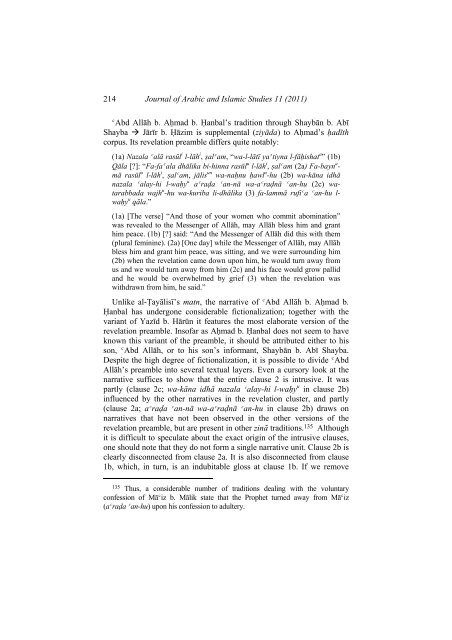JOURNAL OF ARABIC AND ISLAMIC STUDIES
JOURNAL OF ARABIC AND ISLAMIC STUDIES
JOURNAL OF ARABIC AND ISLAMIC STUDIES
Create successful ePaper yourself
Turn your PDF publications into a flip-book with our unique Google optimized e-Paper software.
214<br />
Journal of Arabic and Islamic Studies 11 (2011)<br />
ʿAbd Allāh b. Aḥmad b. Ḥanbal’s tradition through Shaybān b. Abī<br />
Shayba Jārīr b. Ḥāzim is supplemental (ziyāda) to Aḥmad’s ḥadīth<br />
corpus. Its revelation preamble differs quite notably:<br />
(1a) Nazala ʿalā rasūl i l-lāh i , ṣalʿam, “wa-l-lātī yaʾtiyna l-fāḥishat a ” (1b)<br />
Qāla [?]: “Fa-faʿala dhālika bi-hinna rasūl u l-lāh i , ṣalʿam (2a) Fa-bayn a -<br />
mā rasūl u l-lāh i , ṣalʿam, jālis un wa-naḥnu ḥawl a -hu (2b) wa-kāna idhā<br />
nazala ʿalay-hi l-waḥy u aʿraḍa ʿan-nā wa-aʿraḍnā ʿan-hu (2c) watarabbada<br />
wajh u -hu wa-kuriba li-dhālika (3) fa-lammā rufiʿa ʿan-hu lwaḥy<br />
u qāla.”<br />
(1a) [The verse] “And those of your women who commit abomination”<br />
was revealed to the Messenger of Allāh, may Allāh bless him and grant<br />
him peace. (1b) [?] said: “And the Messenger of Allāh did this with them<br />
(plural feminine). (2a) [One day] while the Messenger of Allāh, may Allāh<br />
bless him and grant him peace, was sitting, and we were surrounding him<br />
(2b) when the revelation came down upon him, he would turn away from<br />
us and we would turn away from him (2c) and his face would grow pallid<br />
and he would be overwhelmed by grief (3) when the revelation was<br />
withdrawn from him, he said.”<br />
Unlike al-Ṭayālisī’s matn, the narrative of ʿAbd Allāh b. Aḥmad b.<br />
Ḥanbal has undergone considerable fictionalization; together with the<br />
variant of Yazīd b. Hārūn it features the most elaborate version of the<br />
revelation preamble. Insofar as Aḥmad b. Ḥanbal does not seem to have<br />
known this variant of the preamble, it should be attributed either to his<br />
son, ʿAbd Allāh, or to his son’s informant, Shaybān b. Abī Shayba.<br />
Despite the high degree of fictionalization, it is possible to divide ʿAbd<br />
Allāh’s preamble into several textual layers. Even a cursory look at the<br />
narrative suffices to show that the entire clause 2 is intrusive. It was<br />
partly (clause 2c; wa-kāna idhā nazala ʿalay-hi l-waḥy u in clause 2b)<br />
influenced by the other narratives in the revelation cluster, and partly<br />
(clause 2a; aʿraḍa ʿan-nā wa-aʿraḍnā ʿan-hu in clause 2b) draws on<br />
narratives that have not been observed in the other versions of the<br />
revelation preamble, but are present in other zinā traditions. 135 Although<br />
it is difficult to speculate about the exact origin of the intrusive clauses,<br />
one should note that they do not form a single narrative unit. Clause 2b is<br />
clearly disconnected from clause 2a. It is also disconnected from clause<br />
1b, which, in turn, is an indubitable gloss at clause 1b. If we remove<br />
135 Thus, a considerable number of traditions dealing with the voluntary<br />
confession of Māʿiz b. Mālik state that the Prophet turned away from Māʿiz<br />
(aʿraḍa ʿan-hu) upon his confession to adultery.

















